WHEATSTONE BRIDGE
Wheatstone bridge is an arrangement of four resistances which can be used to measure one of them in terms of rest. Here arms AB and BC are called ratio arm and arms AC and BD are called conjugate arms.
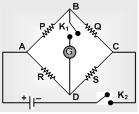
Balanced Wheatstone bridge: The bridge is said to be balanced when deflection in galvanometer is zero i.e. no current flows through the galvanometer or in other words VB = VD. In the balanced condition P/Q = R/S, on mutually changing the position of cell and galvanometer this condition will not change.
Unbalanced Wheatstone bridge: If the bridge is not balanced current will flow from D to B if VD > VB i.e. (VA – VD) < (VA – VB) which gives PS > RQ.
Applications of Wheatstone bridge: Meter bridge, post office box and Carey Foster bridge are instruments based on the principle of Wheatstone bridge and are used to measure unknown resistance.
METER BRIDGE: In case of Meter Bridge, the resistance wire AC is 100 cm long. Varying the position of tapping point B, bridge is balanced. If in balanced position of bridge AB = l,
BC = (100 – l)
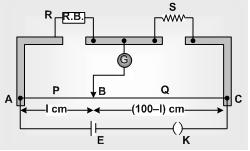
So that .Q/P = (100–l)/l
Also P/Q = R/S ⇒ S = (100–l)/l R
Solved example 1: In Wheatstone bridge P = 9 ohm, Q = 11 ohm, R = 4 ohm and S = 6 ohm. How much resistance must be put in parallel to the resistance S to balance the bridge
(A) 24 ohm (B) 44/9 ohm (C) 26.4 ohm (D) 18.7 ohm
Solution: (C) (For balancing bridge)
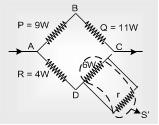
⇒ S' = 4×11/9 = 44/9 ⇒ 1/S' = 1/r + 1/6
⇒ 9/44 – 1/6 = 1/r ⇒ r = 132/5 = 26.4 Ω
Solved example 2: A voltmeter having a resistance of 998 ohms is connected to a cell of emf 2 volt and internal resistance 2 ohm. The error in the measurement of emf will be
(A) 4 ×10–1 volt (B) 2 ×10–3 volt
(C) 4 ×10–3 volt (D) 2 ×10–1 volt
Solution: (C) Error in measurement = Actual value – Measured value
Actual value = 2A
i = 2/998+2 = 1/500 A
Since E = V + ir = ⇒ V = E – ir = 2 – 1/500 × 2 = 998/500 V
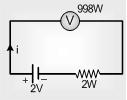
Measured value = 998/500 V ⇒ Error = 2 – 998/500 = 4 × 10–3 volt.
Potentiometer
Potentiometer is a device mainly used to measure emf of a given cell and to compare emf's of cells. It is also used to measure internal resistance of a given cell.
Circuit diagram: Potentiometer consists of a long resistive wire AB of length L (about 6 m to 10 m long) made up of mangnine or constantan and a battery of known voltage e and internal resistance r called supplier battery or driver cell. Connection of these two forms primary circuit.
One terminal of another cell (whose emf E is to be measured) is connected at one end of the main circuit and the other terminal at any point on the resistive wire through a galvanometer G. This forms the secondary circuit. Other details are as follows
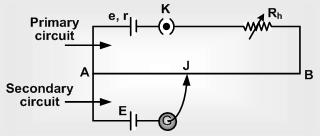
J = Jockey
K = Key
R = Resistance of potentiometer wire,
r = Specific resistance of potentiometer wire.
Rh = Variable resistance which controls the current through the wire AB
(i) The specific resistance (r) of potentiometer wire must be high but its temperature coefficient of resistance (a) must be low.
(ii) All higher potential points (terminals) of primary and secondary circuits must be connected together at point A and all lower potential points must be connected to point B or jockey.
(iii) The value of known potential difference must be greater than the value of unknown potential difference to be measured.
(iv) The potential gradient must remain constant. For this the current in the primary circuit must remain constant and the jockey must not be slided in contact with the wire.
(v) The diameter of potentiometer wire must be uniform everywhere.
Potential gradient (x): Potential difference (or fall in potential) per unit length of wire is called potential gradient i.e. x = V/L volt/m where V = iR = (e/R+Rn+r)R.
So x = V/L = iR/L = ip/A = e/(R+Rh+r) . R/L
(i) Potential gradient directly depends upon
(a) The resistance per unit length (R/L) of potentiometer wire.
(b) The radius of potentiometer wire (i.e. Area of cross-section)
(c) The specific resistance of the material of potentiometer wire (i.e. r)
(d) The current flowing through potentiometer wire (i)
(ii) Potential gradient indirectly depends upon
(a) The emf of battery in the primary circuit (i.e. e)
(b) The resistance of rheostat in the primary circuit (i.e. Rh)
Working: Suppose jockey is made to touch a point J on wire then potential difference between A and J will be V = xl
At this length (l) two potential difference are obtained
(i) V due to battery e and
(ii) E due to unknown cell
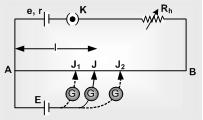
If V > E then current will flow in galvanometer circuit in one direction 

If V < E then current will flow in galvanometer circuit in opposite direction 

If V = E then no current will flow in galvanometer circuit this condition to known as null deflection position, length l is known as balancing length.
In balanced condition E = xl
or E = xl = V/L l = iR/L l = (e/R+Rh+r) × R/L × l
If V is constant then L ∝ l ⇒ x1/x2 = L1L2 = l1/l2
Standardization of Potentiometer: The process of determining potential gradient experimentally is known as standardization of potentiometer.
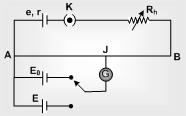
Let the balancing length for the standard emf E0 is l0 then by the principle of potentiometer E0 = xl0 ⇒ x = E0/l0
Sensitivity of potentiometer: A potentiometer is said to be more sensitive, if it measures a small potential difference more accurately.
(i) The sensitivity of potentiometer is assessed by its potential gradient. The sensitivity is inversely proportional to the potential gradient.
(ii) In order to increase the sensitivity of potentiometer
(a) The resistance in primary circuit will have to be decreased.
(b) The length of potentiometer wire will have to be increased so that the length may be measured more accuracy.
Difference between voltmeter and potentiometer
Voltmeter | Potentiometer |
It's resistance is high but finite | It's resistance is infinite |
It draws some current from source of emf | It does not draw any current from the source of unknown emf |
The potential difference measured by it is lesser than the actual potential difference | The potential difference measured by it is equal to actual potential difference |
Its sensitivity is low | Its sensitivity is high |
It is a versatile instrument | It measures only emf or potential difference |
It is based on deflection method | It is based on zero deflection method |






2 comments:
Really nice work for student !
To get more questions, you can also consider using website www.jsuniltutorial.weebly.com
Why leclanche cell is prefered for meter bridge ?
Post a Comment